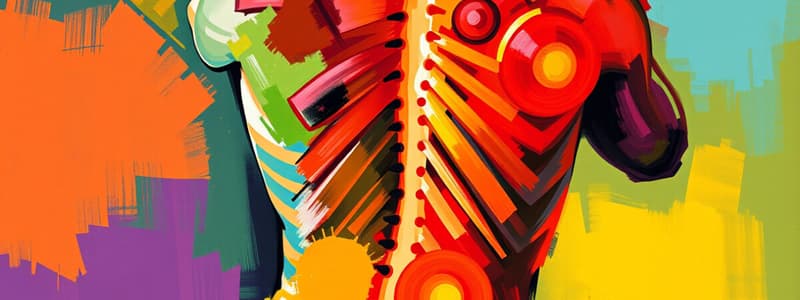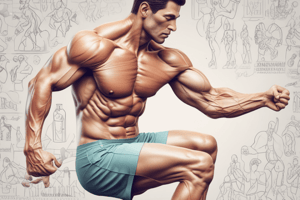Podcast
Questions and Answers
What primarily distinguishes a back sprain from a back strain?
What primarily distinguishes a back sprain from a back strain?
- Only ligamentous tissue is affected (correct)
- Muscle fibers are torn
- Involves dislocation and fracture
- Occurs due to excessive weight on the spine
What is a common cause of back strain in sports?
What is a common cause of back strain in sports?
- Improper weight distribution on the spine (correct)
- Lack of flexibility training
- Direct punches to the back
- Injury during contact sports
Which muscle acts mainly as an accessory respiratory muscle by aiding in rib elevation during deep inspiration?
Which muscle acts mainly as an accessory respiratory muscle by aiding in rib elevation during deep inspiration?
- Erector spinae
- Pectoralis major (correct)
- Transversus abdominis
- Latissimus dorsi
What defines a muscle spasm in response to injury?
What defines a muscle spasm in response to injury?
Which of the following muscles primarily acts on the vertebral column?
Which of the following muscles primarily acts on the vertebral column?
What role does the axio-appendicular muscle group serve?
What role does the axio-appendicular muscle group serve?
Which condition is characterized by excessive muscular contraction resulting in fatigue and tearing?
Which condition is characterized by excessive muscular contraction resulting in fatigue and tearing?
What primarily occurs during a back sprain?
What primarily occurs during a back sprain?
Which muscles help elevate the lower ribs during forced inspiration?
Which muscles help elevate the lower ribs during forced inspiration?
What are the functions of the diaphragm during respiration?
What are the functions of the diaphragm during respiration?
Which of the following best describes the position of the domes of the diaphragm?
Which of the following best describes the position of the domes of the diaphragm?
What type of muscle is the transversus abdominis?
What type of muscle is the transversus abdominis?
Which part of the diaphragm is primarily responsible for inspiration?
Which part of the diaphragm is primarily responsible for inspiration?
Which statement regarding the crura of the diaphragm is correct?
Which statement regarding the crura of the diaphragm is correct?
How many flat muscles are part of the anterolateral muscles of the abdomen?
How many flat muscles are part of the anterolateral muscles of the abdomen?
Which of the following correctly identifies a function of the abdominal muscles?
Which of the following correctly identifies a function of the abdominal muscles?
Which of the following describes the structural feature of the diaphragm?
Which of the following describes the structural feature of the diaphragm?
What is the anatomical importance of the right crus of the diaphragm?
What is the anatomical importance of the right crus of the diaphragm?
What structure lies below the pelvic diaphragm forming the deep perineal pouch?
What structure lies below the pelvic diaphragm forming the deep perineal pouch?
Which of the following is NOT a boundary of the deep perineal pouch?
Which of the following is NOT a boundary of the deep perineal pouch?
In males, what anatomical feature does the urogenital triangle primarily enclose?
In males, what anatomical feature does the urogenital triangle primarily enclose?
Which statement regarding the differences in deep perineal musculature between sexes is accurate?
Which statement regarding the differences in deep perineal musculature between sexes is accurate?
What is the consequence of tearing the puborectalis muscle?
What is the consequence of tearing the puborectalis muscle?
Which area of the perineal region is identified as the anal triangle?
Which area of the perineal region is identified as the anal triangle?
What primarily forms the anterior wall of the pelvic floor?
What primarily forms the anterior wall of the pelvic floor?
Which muscles contribute to the posterior wall of the pelvic floor?
Which muscles contribute to the posterior wall of the pelvic floor?
What is the primary function of the pelvic floor muscles?
What is the primary function of the pelvic floor muscles?
At what point does the posterior wall of the pelvic floor end?
At what point does the posterior wall of the pelvic floor end?
Which muscles are part of the pelvic diaphragm?
Which muscles are part of the pelvic diaphragm?
What is the primary function of the muscles forming a firm wall in the abdominal area?
What is the primary function of the muscles forming a firm wall in the abdominal area?
Which statement accurately describes the relationship of the rectus abdominis in the pelvic region?
Which statement accurately describes the relationship of the rectus abdominis in the pelvic region?
What shape describes the pelvic floor?
What shape describes the pelvic floor?
Which action is NOT mentioned as being assisted by the contraction of abdominal muscles?
Which action is NOT mentioned as being assisted by the contraction of abdominal muscles?
What does the rectus sheath primarily serve as?
What does the rectus sheath primarily serve as?
Which of the following is a function of the pelvic floor muscles regarding material movement?
Which of the following is a function of the pelvic floor muscles regarding material movement?
Which of the following actions increases intra-abdominal pressure?
Which of the following actions increases intra-abdominal pressure?
Which muscle is NOT part of the pelvic diaphragm?
Which muscle is NOT part of the pelvic diaphragm?
What anatomical transition does the pelvis signify?
What anatomical transition does the pelvis signify?
Which of these functions is related to maintaining posture?
Which of these functions is related to maintaining posture?
What role do abdominal muscles play during vomiting?
What role do abdominal muscles play during vomiting?
What is NOT a characteristic of the rectus sheath?
What is NOT a characteristic of the rectus sheath?
Which of the following is a consequence of increased intra-abdominal pressure?
Which of the following is a consequence of increased intra-abdominal pressure?
Which layer or structure helps contain and support abdominal organs against gravity?
Which layer or structure helps contain and support abdominal organs against gravity?
Flashcards are hidden until you start studying
Study Notes
Strains vs Spasms
- Back Sprain: Involves only ligamentous tissue; occurs without dislocation or fracture due to excessively strong contractions during vertebral movements.
- Back Strain: Common in sports; results from overly strong muscular contractions leading to stretching or tearing of muscle fibers; improperly balanced weight on the vertebral column causes muscle strain.
- Muscle Spasm: A protective involuntary contraction of one or more muscle groups triggered by injury or inflammation.
Thoracic Wall Muscles
- Function: Alter the position of ribs and sternum, changing thoracic volume during breathing; reinforce thoracic wall.
- Axio-appendicular Muscles: Connect thoracic cage to upper limb bones; primarily act on upper limbs.
- Key Muscles:
- Pectoralis Major and Minor: Accessory muscles for respiration; elevate ribs during deep inspiration.
- Scalene Muscles: Aid in respiration by fixing ribs, enhancing effectiveness of muscles elevating lower ribs during forced inspiration.
Muscles of the Abdomen
- Anterolateral Muscles: Comprise five key muscles.
- Flat Muscles: External oblique, internal oblique, transversus abdominis.
- Vertical Muscles: Rectus abdominis, pyramidalis.
Diaphragm
- Structure: Double-domed musculotendinous partition separating thoracic and abdominal cavities; chief muscle of inspiration.
- Mechanics: Descends during inspiration; right dome is typically higher due to the liver.
- Functionality: Aids in normal physiological functions, maintains abdominal viscera positioning, assists in expiration (quiet and forced), and increases intraabdominal pressure during actions like defecation.
Rectus Sheath, Linea Alba, and Umbilical Ring
- Rectus Sheath: Strong fibrous compartment for the rectus abdominis and pyramidalis; consists of anterior and posterior walls formed by aponeuroses of flat abdominal muscles.
- Functions: Supports pelvic cavity organs, flexes sacrum/coccyx, controls material movement through urethra and anus.
Pelvis and Perineum
- Pelvis: Acts as a transition zone between trunk and lower limbs; includes the pelvic diaphragm formed by coccygeus and levator ani muscles.
- Perineum: Diamond-shaped region between external genitalia and anus; divided into anal triangle (posterior) and urogenital triangle (anterior).
- Boundaries: Anterior by pubic symphysis, posterior by coccyx, lateral by inferior pubic rami, with the pelvic floor as the roof.
- Urogenital Triangle: Hosts external genitalia roots; contains urethra and vagina openings in females, and urethra encased in erectile tissue in males.
- Anal Triangle: Contains the anus and external anal sphincter; musculature is similar in both sexes.
- Clinical Note: Tearing of puborectalis can lead to fecal incontinence.
Studying That Suits You
Use AI to generate personalized quizzes and flashcards to suit your learning preferences.



